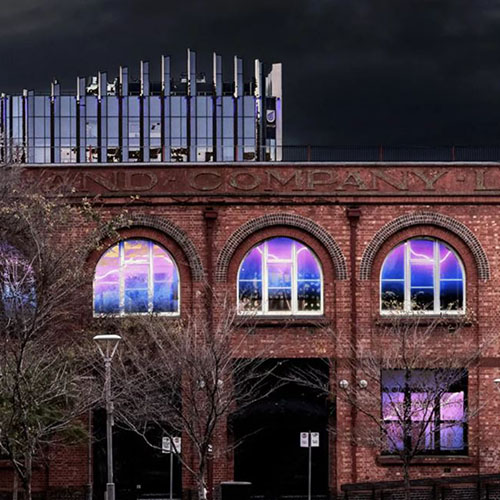05 June 2025

Architects, builders, academics and regulators are calling for a major shift in Australia’s building policies, claiming these are based on a narrow view of environmental costs and false economies that downplay the real costs of new builds - and the environment is paying the price.
The consortium comprises representatives across Australia’s property sector, including developers, architects, industry bodies, environmental and heritage consultants, government and researchers. The group gathered last month at Hames Sharley architects’ Adelaide office, to work through the challenges holding back the sustainable re-use of buildings and agree on a framework to progress building adaptation for housing and other purposes.
A total of 24 recommendations were developed, including:
- Adapting and reusing existing buildings must be the first option before considering redevelopment - across housing, community and commercial functions.
- Government should lead by adapting building policies to prioritise sufficiency and adaptive building reuse, and should lead through its own accommodation choices.
- A database of vacant precincts, buildings and land must be established to identify opportunities for adaptive reuse and redirect investment.
- Building policy must change to recognise embodied carbon saved by reuse rather than demolition and rebuild - and better balance this with the energy efficiencies of new builds.
- Economic incentives such as tax relief and reduced charges are vital to recognise the environmental savings from reusing existing buildings and make adaptive reuse viable.
The University of South Australia co-hosted the workshop in partnership with Hames Sharley, also involving the City of Adelaide and University of Adelaide.
Professor David Ness, from UniSA’s Centre for Sustainable Infrastructure and Resource Management (SIRM) and co-founder of World Sufficiency Lab, Paris, has long advocated for recognising the environmental savings resulting from adaptive reuse of buildings,
He points out that “while new builds are lauded for their energy efficiencies, large amounts of carbon are ‘embodied’ in their materials and construction while they consume excessive water and other natural resources. This can be greatly reduced by adapting vacant and underutilised existing buildings, which otherwise go to waste.”
“The building industry represents around a third of global carbon emissions, yet we’re seeing more and bigger builds by default. This seems far out of step with EU countries such as France and Denmark, where attention is focussed on making better use of existing space.
“It’s therefore critical that our policy settings prioritise building retention, retrofit and reuse ‑ instead of new builds.”
Hames Sharley Associate Director and Head of its National Sustainability Forum, Yaara Plaves, says bringing key stakeholders together is vital to address cross-sector issues.
“In any field where complex, systemic challenges resist straightforward solutions, siloed expertise creates blind spots and biases,” Plaves says. “Addressing these through a community of practice model that brings participants together cultivates learning and mutual trust - and is essential to bring about sustainable, demonstratable solutions.”
Supported by the Australian-French Association for Research and Innovation (AFRAN), the workshop involved sharing learnings from France’s innovative policies and initiatives, including the concept of ‘Sufficiency’ which is now enshrined in French Energy Law and reflected in more holistic policies on carbon mitigation.
The recommendations will be shared with South Australian policy makers, and a bilateral partnership with France explored through a proposed Adelaide University-based ‘Australian Sufficiency Lab’, which would become a national centre for sufficiency and adaptive reuse across multiple sectors.
The recommendations were developed by representatives from the below entities:
|
ARUP |
Future Urban
|
RPS Engineering |
|
ARCHI |
Greenaway Consulting
|
Sarah Constructions |
|
Australian Institute of Architects |
Heritage South Australia
|
SA Dept of Infrastructure & Transport |
|
Built Australia |
Hames Sharley |
State Planning Commission |
|
City of Adelaide
|
Lendlease |
University of Adelaide |
|
Cohen Group
|
Les Moore Projects
|
University of South Australia
|
|
FORUM |
Pelligra |
|
Participant quotes:
Professor Jane Burry, Chair, Architecture and Civil Engineering, University of Adelaide: “The session provided a great springboard to go forward.”
Les Moore, Les Moore Projects: “With the right ‘can-do’ mindset we can achieve extraordinary outcomes.”
About Hames Sharley:
Hames Sharley is a research-led design practice with a large community of designers and collaborators. We identify knowledge gaps and, through our practice-based research, we hunt for answers to influence a better built environment. Our research projects are broad and include areas such as understanding the impact of noise in ICU and designing for sensory comfort in workplace settings.
About UniSA:
The University of South Australia and the University of Adelaide are joining forces to become Australia’s new major university – Adelaide University. Building on the strengths, legacies and resources of two leading universities, Adelaide University will deliver globally relevant research at scale, innovative, industry-informed teaching and an outstanding student experience. Adelaide University will open its doors in January 2026. Find out more on the Adelaide University website.
Media contacts:
Interviews: Professor David Ness M: +61 401 122 651 E: david.ness@unisa.edu.au
Megan Andrews M: +61 434 819 275 E: megan.andrews@unisa.edu.au



